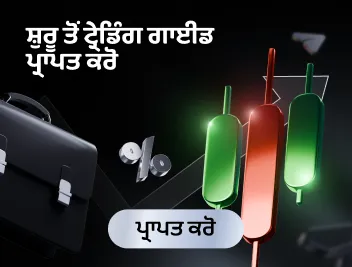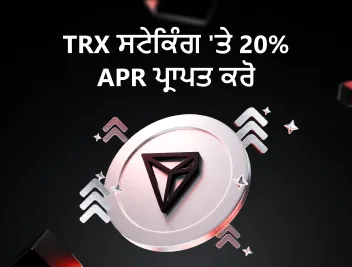
ਕ੍ਰਿਪਟੋ ਵਿੱਚ ਨੈੱਟਵਰਕ ਫੀਸ ਕੀ ਹੈ?
ਕੀ ਤੁਸੀਂ ਕਦੇ ਸੋਚਿਆ ਹੈ ਕਿ ਕ੍ਰਿਪਟੋਕਰੰਸੀ ਭੇਜਣ 'ਤੇ ਕਈ ਵਾਰ ਉਮੀਦ ਤੋਂ ਵੱਧ ਖਰਚਾ ਕਿਉਂ ਆਉਂਦਾ ਹੈ? ਨੈੱਟਵਰਕ ਫੀਸਾਂ ਵਿੱਚ ਨਾਟਕੀ ਢੰਗ ਨਾਲ ਉਤਰਾਅ-ਚੜ੍ਹਾਅ ਆ ਸਕਦਾ ਹੈ, ਜਿਸ ਨਾਲ ਲੈਣ-ਦੇਣ ਜ਼ਿਆਦਾ ਮਹਿੰਗਾ ਹੋ ਜਾਂਦਾ ਹੈ। ਕ੍ਰਿਪਟੋ ਸਪੇਸ ਨੂੰ ਕੁਸ਼ਲਤਾ ਨਾਲ ਨੈਵੀਗੇਟ ਕਰਨ ਅਤੇ ਬੇਲੋੜੇ ਖਰਚਿਆਂ ਤੋਂ ਬਚਣ ਲਈ ਇਹਨਾਂ ਫੀਸਾਂ ਨੂੰ ਸਮਝਣਾ ਬਹੁਤ ਜ਼ਰੂਰੀ ਹੈ। ਇਸ ਲੇਖ ਵਿੱਚ, ਅਸੀਂ ਇਹ ਦੱਸਾਂਗੇ ਕਿ ਨੈੱਟਵਰਕ ਫੀਸ ਕੀ ਹੈ, ਇਹ ਕਿਵੇਂ ਕੰਮ ਕਰਦੀ ਹੈ, ਅਤੇ ਇਹ ਕਿਉਂ ਬਦਲਦੀ ਹੈ। ਆਓ ਇਸ ਵਿੱਚ ਡੁਬਕੀ ਮਾਰੀਏ!
ਟ੍ਰਾਂਜੈਕਸ਼ਨ ਫੀਸਾਂ ਕਿਵੇਂ ਕੰਮ ਕਰਦੀਆਂ ਹਨ?
ਇਸ ਤੋਂ ਪਹਿਲਾਂ ਕਿ ਅਸੀਂ ਇਸ ਵਿੱਚ ਡੁਬਕੀ ਮਾਰੀਏ ਕਿ ਟ੍ਰਾਂਜੈਕਸ਼ਨ ਫੀਸਾਂ ਕਿਵੇਂ ਕੰਮ ਕਰਦੀਆਂ ਹਨ, ਆਓ ਪਹਿਲਾਂ ਸਮਝੀਏ ਕਿ ਉਹ ਕੀ ਹਨ। ਨੈੱਟਵਰਕ ਫੀਸ ਬਲਾਕਚੈਨ 'ਤੇ ਟ੍ਰਾਂਜੈਕਸ਼ਨਾਂ ਦੀ ਪ੍ਰਕਿਰਿਆ ਕਰਨ ਲਈ ਲਈ ਜਾਂਦੀ ਫੀਸ ਹੈ। ਮਾਈਨਰਾਂ ਅਤੇ ਪ੍ਰਮਾਣਕਾਂ ਨੂੰ ਉਤਸ਼ਾਹਿਤ ਕਰਨਾ ਜ਼ਰੂਰੀ ਹੈ ਜੋ ਨੈੱਟਵਰਕ ਦੀ ਸੁਰੱਖਿਆ ਨੂੰ ਯਕੀਨੀ ਬਣਾਉਂਦੇ ਹਨ। ਹਰੇਕ ਟ੍ਰਾਂਜੈਕਸ਼ਨ ਨੂੰ ਬਲਾਕ ਵਿੱਚ ਜੋੜਨ ਤੋਂ ਪਹਿਲਾਂ ਪੁਸ਼ਟੀ ਕੀਤੀ ਜਾਣੀ ਚਾਹੀਦੀ ਹੈ, ਅਤੇ ਫੀਸ ਦਾ ਆਕਾਰ ਇਸਦੀ ਤਰਜੀਹ ਨੂੰ ਪ੍ਰਭਾਵਿਤ ਕਰਦਾ ਹੈ: ਫੀਸ ਜਿੰਨੀ ਜ਼ਿਆਦਾ ਹੋਵੇਗੀ, ਟ੍ਰਾਂਜੈਕਸ਼ਨ ਓਨੀ ਹੀ ਤੇਜ਼ੀ ਨਾਲ ਪ੍ਰਕਿਰਿਆ ਕੀਤੀ ਜਾਵੇਗੀ।
ਜਦੋਂ ਕੋਈ ਉਪਭੋਗਤਾ ਕ੍ਰਿਪਟੋਕਰੰਸੀ ਭੇਜਦਾ ਹੈ, ਤਾਂ ਉਹਨਾਂ ਦੇ ਟ੍ਰਾਂਜੈਕਸ਼ਨ ਨੂੰ ਮੈਮਪੂਲ ਵਿੱਚ ਭੇਜਿਆ ਜਾਂਦਾ ਹੈ - ਲੰਬਿਤ ਕਾਰਜਾਂ ਲਈ ਇੱਕ ਕਿਸਮ ਦੀ ਕਤਾਰ। ਮਾਈਨਰਾਂ ਅਤੇ ਵੈਲੀਡੇਟਰਾਂ ਨੂੰ ਉਹਨਾਂ ਦੀ ਪ੍ਰਕਿਰਿਆ ਕਰਨ ਲਈ ਪ੍ਰੇਰਿਤ ਕਰਨ ਲਈ, ਉਪਭੋਗਤਾ ਇੱਕ ਨੈੱਟਵਰਕ ਫੀਸ ਅਦਾ ਕਰਦੇ ਹਨ: ਜਿੰਨੀ ਜ਼ਿਆਦਾ ਰਕਮ ਹੋਵੇਗੀ, ਟ੍ਰਾਂਜੈਕਸ਼ਨ ਨੂੰ ਬਲਾਕ ਵਿੱਚ ਓਨੀ ਹੀ ਜਲਦੀ ਸ਼ਾਮਲ ਕੀਤਾ ਜਾਵੇਗਾ।
ਬਲਾਕਚੈਨ ਵਿੱਚ ਟ੍ਰਾਂਜੈਕਸ਼ਨ ਫੀਸ ਕਈ ਮਹੱਤਵਪੂਰਨ ਉਦੇਸ਼ਾਂ ਦੀ ਪੂਰਤੀ ਕਰਦੀ ਹੈ:
-
ਸਪੈਮ ਹਮਲਿਆਂ ਨੂੰ ਰੋਕਣਾ। ਇੱਕ ਉੱਚ ਟ੍ਰਾਂਜੈਕਸ਼ਨ ਫੀਸ ਹਮਲਾਵਰਾਂ ਨੂੰ ਅਰਥਹੀਣ ਕਾਰਜਾਂ ਨਾਲ ਨੈੱਟਵਰਕ ਨੂੰ ਹਾਵੀ ਕਰਨ ਤੋਂ ਰੋਕਦੀ ਹੈ।
-
ਕੰਪਿਊਟੇਸ਼ਨਲ ਸਰੋਤਾਂ ਨੂੰ ਮੁਆਵਜ਼ਾ ਦੇਣਾ। ਮਾਈਨਰਾਂ ਅਤੇ ਵੈਲੀਡੇਟਰਾਂ ਨੂੰ ਉਨ੍ਹਾਂ ਦੇ ਕੰਮ ਲਈ ਇਨਾਮ ਦਿੱਤਾ ਜਾਂਦਾ ਹੈ, ਇਹ ਯਕੀਨੀ ਬਣਾਉਂਦੇ ਹੋਏ ਕਿ ਨੈੱਟਵਰਕ ਸਥਿਰ ਰਹੇ।
-
ਵਿਕੇਂਦਰੀਕਰਣ ਨੂੰ ਬਣਾਈ ਰੱਖਣਾ। ਫੀਸਾਂ ਨੈੱਟਵਰਕ ਭਾਗੀਦਾਰਾਂ ਨੂੰ ਕੇਂਦਰੀਕ੍ਰਿਤ ਪ੍ਰਬੰਧਨ ਤੋਂ ਬਿਨਾਂ ਸਿਸਟਮ ਨੂੰ ਚੱਲਦਾ ਰੱਖਣ ਲਈ ਉਤਸ਼ਾਹਿਤ ਕਰਦੀਆਂ ਹਨ।
ਨੈੱਟਵਰਕ 'ਤੇ ਨਿਰਭਰ ਕਰਦੇ ਹੋਏ, ਗਣਨਾ ਵਿਧੀ ਵੱਖ-ਵੱਖ ਹੋ ਸਕਦੀ ਹੈ; ਉਦਾਹਰਨ ਲਈ, ਬਿਟਕੋਇਨ ਵਿੱਚ, ਇਹ ਡੇਟਾ ਦੇ ਆਕਾਰ 'ਤੇ ਨਿਰਭਰ ਕਰਦਾ ਹੈ, ਜਦੋਂ ਕਿ ਈਥਰਿਅਮ ਵਿੱਚ, ਇਹ ਗੈਸ ਫੀਸ 'ਤੇ ਅਧਾਰਤ ਹੈ। ਅੰਤ ਵਿੱਚ, ਨੈੱਟਵਰਕ ਫੀਸ ਬਲਾਕਚੈਨ ਦੀ ਕਾਰਜਸ਼ੀਲਤਾ ਅਤੇ ਸੁਰੱਖਿਆ ਨੂੰ ਬਣਾਈ ਰੱਖਣ ਵਿੱਚ ਇੱਕ ਮਹੱਤਵਪੂਰਨ ਭੂਮਿਕਾ ਨਿਭਾਉਂਦੀ ਹੈ, ਇਹ ਯਕੀਨੀ ਬਣਾਉਂਦੀ ਹੈ ਕਿ ਨਵੇਂ ਬਲਾਕਾਂ ਵਿੱਚ ਸਿਰਫ਼ ਵੈਧ ਟ੍ਰਾਂਜੈਕਸ਼ਨਾਂ ਨੂੰ ਹੀ ਸ਼ਾਮਲ ਕੀਤਾ ਜਾਵੇ।
ਨੈੱਟਵਰਕ ਫੀਸਾਂ ਦੀਆਂ ਕਿਸਮਾਂ
ਨੈੱਟਵਰਕ ਫੀਸਾਂ ਬਲਾਕਚੈਨ ਵਿੱਚ ਵਰਤੇ ਗਏ ਸਹਿਮਤੀ ਵਿਧੀ ਦੇ ਅਧਾਰ ਤੇ ਵੱਖ-ਵੱਖ ਹੁੰਦੀਆਂ ਹਨ। ਦੋ ਮੁੱਖ ਕਿਸਮਾਂ ਹਨ ਮਾਈਨਿੰਗ ਫੀਸ ਪਰੂਫ-ਆਫ-ਵਰਕ (PoW) ਸਿਸਟਮਾਂ ਵਿੱਚ ਅਤੇ ਗੈਸ ਫੀਸ ਪਰੂਫ-ਆਫ-ਸਟੇਕ (PoS) ਅਤੇ ਇਸ ਤਰ੍ਹਾਂ ਦੇ ਮਾਡਲਾਂ ਵਿੱਚ। ਆਓ ਹਰੇਕ 'ਤੇ ਇੱਕ ਡੂੰਘੀ ਵਿਚਾਰ ਕਰੀਏ।
ਮਾਈਨਿੰਗ ਫੀਸ
PoW-ਅਧਾਰਿਤ ਬਲਾਕਚੈਨ ਜਿਵੇਂ ਕਿ Bitcoin ਵਿੱਚ, ਨੈੱਟਵਰਕ ਫੀਸਾਂ ਟ੍ਰਾਂਜੈਕਸ਼ਨ ਦੇ ਆਕਾਰ ਦੁਆਰਾ ਇਸਦੇ ਮੁਦਰਾ ਮੁੱਲ ਦੀ ਬਜਾਏ ਬਾਈਟਾਂ ਵਿੱਚ ਨਿਰਧਾਰਤ ਕੀਤੀਆਂ ਜਾਂਦੀਆਂ ਹਨ। ਹਰੇਕ ਟ੍ਰਾਂਜੈਕਸ਼ਨ ਨੂੰ ਇੱਕ ਬਲਾਕ ਵਿੱਚ ਸ਼ਾਮਲ ਕੀਤਾ ਜਾਣਾ ਚਾਹੀਦਾ ਹੈ, ਅਤੇ ਕਿਉਂਕਿ ਬਲਾਕ ਸਪੇਸ ਸੀਮਤ ਹੈ, ਉਪਭੋਗਤਾ ਆਪਣੇ ਟ੍ਰਾਂਜੈਕਸ਼ਨਾਂ ਨੂੰ ਤਰਜੀਹ ਦੇਣ ਲਈ ਉੱਚ ਫੀਸਾਂ ਦੀ ਪੇਸ਼ਕਸ਼ ਕਰਕੇ ਮੁਕਾਬਲਾ ਕਰਦੇ ਹਨ। ਇੱਥੇ ਮੁੱਖ ਕਾਰਕ ਹਨ ਜੋ ਬਿਟਕੋਇਨ ਟ੍ਰਾਂਜੈਕਸ਼ਨ ਫੀਸਾਂ ਨੂੰ ਨਿਰਧਾਰਤ ਕਰਦੇ ਹਨ:
-
ਟ੍ਰਾਂਜੈਕਸ਼ਨ ਦਾ ਆਕਾਰ ਮਾਇਨੇ ਰੱਖਦਾ ਹੈ: ਰਵਾਇਤੀ ਵਿੱਤੀ ਪ੍ਰਣਾਲੀਆਂ ਦੇ ਉਲਟ ਜਿੱਥੇ ਫੀਸਾਂ ਅਕਸਰ ਪ੍ਰਤੀਸ਼ਤ-ਅਧਾਰਤ ਹੁੰਦੀਆਂ ਹਨ, ਬਿਟਕੋਇਨ ਅਤੇ ਸਮਾਨ ਨੈੱਟਵਰਕਾਂ ਵਿੱਚ, ਫੀਸਾਂ ਇਸ ਗੱਲ 'ਤੇ ਨਿਰਭਰ ਕਰਦੀਆਂ ਹਨ ਕਿ ਇੱਕ ਟ੍ਰਾਂਜੈਕਸ਼ਨ ਇੱਕ ਬਲਾਕ ਵਿੱਚ ਕਿੰਨੀ ਜਗ੍ਹਾ ਰੱਖਦਾ ਹੈ। ਵੱਡੇ ਟ੍ਰਾਂਜੈਕਸ਼ਨਾਂ (ਜਿਵੇਂ ਕਿ, ਕਈ ਇਨਪੁਟ ਅਤੇ ਆਉਟਪੁੱਟ ਵਾਲੇ) ਨੂੰ ਵਧੇਰੇ ਜਗ੍ਹਾ ਦੀ ਲੋੜ ਹੁੰਦੀ ਹੈ ਅਤੇ ਇਸ ਤਰ੍ਹਾਂ ਉੱਚ ਫੀਸਾਂ ਲੱਗਦੀਆਂ ਹਨ।
-
ਗਤੀਸ਼ੀਲ ਕੀਮਤ: ਨੈੱਟਵਰਕ ਭੀੜ ਦੇ ਆਧਾਰ 'ਤੇ ਟ੍ਰਾਂਜੈਕਸ਼ਨ ਫੀਸਾਂ ਦੀ ਲਾਗਤ ਉਤਰਾਅ-ਚੜ੍ਹਾਅ ਕਰਦੀ ਹੈ। ਜਦੋਂ ਬਹੁਤ ਸਾਰੇ ਟ੍ਰਾਂਜੈਕਸ਼ਨ ਮੈਮਪੂਲ ਵਿੱਚ ਉਡੀਕ ਕਰ ਰਹੇ ਹੁੰਦੇ ਹਨ, ਤਾਂ ਤੇਜ਼ ਪ੍ਰਕਿਰਿਆ ਚਾਹੁੰਦੇ ਉਪਭੋਗਤਾਵਾਂ ਨੂੰ ਆਪਣੇ ਟ੍ਰਾਂਜੈਕਸ਼ਨਾਂ ਨੂੰ ਤਰਜੀਹ ਦੇਣ ਲਈ ਉੱਚ ਫੀਸਾਂ ਦੀ ਪੇਸ਼ਕਸ਼ ਕਰਨੀ ਪੈਂਦੀ ਹੈ। ਇਸ ਦੇ ਉਲਟ, ਘੱਟ ਗਤੀਵਿਧੀ ਦੇ ਸਮੇਂ ਦੌਰਾਨ, ਫੀਸਾਂ ਘੱਟ ਜਾਂਦੀਆਂ ਹਨ।
-
ਮਾਈਨਰ ਪ੍ਰੋਤਸਾਹਨ: ਮਾਈਨਰ, ਜੋ ਬਲਾਕਚੈਨ ਵਿੱਚ ਟ੍ਰਾਂਜੈਕਸ਼ਨਾਂ ਨੂੰ ਪ੍ਰਮਾਣਿਤ ਕਰਦੇ ਹਨ ਅਤੇ ਜੋੜਦੇ ਹਨ, ਆਪਣੀ ਕਮਾਈ ਨੂੰ ਵੱਧ ਤੋਂ ਵੱਧ ਕਰਨ ਲਈ ਉੱਚ ਫੀਸਾਂ ਵਾਲੇ ਲੋਕਾਂ ਨੂੰ ਤਰਜੀਹ ਦਿੰਦੇ ਹਨ। ਕਿਉਂਕਿ ਮਾਈਨਿੰਗ ਲਈ ਮਹੱਤਵਪੂਰਨ ਕੰਪਿਊਟੇਸ਼ਨਲ ਪਾਵਰ ਅਤੇ ਊਰਜਾ ਦੀ ਲੋੜ ਹੁੰਦੀ ਹੈ, ਟ੍ਰਾਂਜੈਕਸ਼ਨ ਫੀਸ ਬਲਾਕ ਇਨਾਮਾਂ ਦੇ ਨਾਲ ਇੱਕ ਵਾਧੂ ਪ੍ਰੋਤਸਾਹਨ ਵਜੋਂ ਕੰਮ ਕਰਦੀ ਹੈ।
ਗੈਸ ਫੀਸ
ਈਥਰਿਅਮ ਵਿੱਚ ਅਤੇ ਹੋਰ PoS-ਅਧਾਰਿਤ ਬਲਾਕਚੈਨ, ਨੈੱਟਵਰਕ ਫੀਸਾਂ ਦੀ ਗਣਨਾ ਸਿਰਫ਼ ਡੇਟਾ ਆਕਾਰ ਦੀ ਬਜਾਏ ਕੰਪਿਊਟੇਸ਼ਨਲ ਸਰੋਤਾਂ ਦੇ ਆਧਾਰ 'ਤੇ ਕੀਤੀ ਜਾਂਦੀ ਹੈ। ਇਸਨੂੰ ਗੈਸ ਫੀਸ ਵਜੋਂ ਜਾਣਿਆ ਜਾਂਦਾ ਹੈ, ਜੋ ਨੈੱਟਵਰਕ 'ਤੇ ਕਾਰਜਾਂ ਨੂੰ ਚਲਾਉਣ ਦੀ ਲਾਗਤ ਨੂੰ ਦਰਸਾਉਂਦਾ ਹੈ। ਗੈਸ ਫੀਸ ਪ੍ਰਣਾਲੀ ਦੇ ਮੁੱਖ ਪਹਿਲੂਆਂ ਵਿੱਚ ਸ਼ਾਮਲ ਹਨ:
-
ਗੈਸ ਯੂਨਿਟ: ਈਥਰਿਅਮ 'ਤੇ ਹਰ ਕਾਰਵਾਈ, ਭਾਵੇਂ ETH ਭੇਜਣਾ ਹੋਵੇ, ਸਮਾਰਟ ਕੰਟਰੈਕਟ ਨਾਲ ਇੰਟਰੈਕਟ ਕਰਨਾ ਹੋਵੇ ਜਾਂ NFT ਨੂੰ minting ਕਰਨਾ ਹੋਵੇ, ਲਈ ਇੱਕ ਖਾਸ ਮਾਤਰਾ ਵਿੱਚ ਗੈਸ ਦੀ ਲੋੜ ਹੁੰਦੀ ਹੈ, ਜੋ ਕਿ ਯੂਨਿਟਾਂ ਵਿੱਚ ਮਾਪੀ ਜਾਂਦੀ ਹੈ। ਓਪਰੇਸ਼ਨ ਜਿੰਨਾ ਗੁੰਝਲਦਾਰ ਹੋਵੇਗਾ, ਓਨਾ ਹੀ ਜ਼ਿਆਦਾ ਗੈਸ ਦੀ ਖਪਤ ਹੋਵੇਗੀ।
-
ਫ਼ੀਸ ਢਾਂਚਾ (EIP-1559 ਅੱਪਗ੍ਰੇਡ): ਈਥਰਿਅਮ ਦੇ ਫੀਸ ਮਾਡਲ ਵਿੱਚ ਦੋ ਹਿੱਸੇ ਹੁੰਦੇ ਹਨ: ਇੱਕ ਬੇਸ ਫੀਸ, ਜੋ ਕਿ ਨੈੱਟਵਰਕ ਭੀੜ ਦੇ ਆਧਾਰ 'ਤੇ ਗਤੀਸ਼ੀਲ ਤੌਰ 'ਤੇ ਐਡਜਸਟ ਕੀਤੀ ਜਾਂਦੀ ਹੈ ਅਤੇ ETH ਸਪਲਾਈ ਨੂੰ ਘਟਾਉਣ ਲਈ ਸਾੜ ਦਿੱਤੀ ਜਾਂਦੀ ਹੈ, ਅਤੇ ਇੱਕ ਤਰਜੀਹੀ ਫੀਸ (ਟਿਪ), ਜਿਸਨੂੰ ਉਪਭੋਗਤਾ ਪ੍ਰਮਾਣਕਾਂ ਨੂੰ ਆਪਣੇ ਲੈਣ-ਦੇਣ ਨੂੰ ਤੇਜ਼ੀ ਨਾਲ ਪ੍ਰਕਿਰਿਆ ਕਰਨ ਲਈ ਉਤਸ਼ਾਹਿਤ ਕਰਨ ਲਈ ਜੋੜ ਸਕਦੇ ਹਨ।
-
ਨੈੱਟਵਰਕ ਕੁਸ਼ਲਤਾ: PoW ਦੇ ਉਲਟ, ਜਿੱਥੇ ਫੀਸਾਂ ਮੁੱਖ ਤੌਰ 'ਤੇ ਲੈਣ-ਦੇਣ ਦੇ ਆਕਾਰ 'ਤੇ ਨਿਰਭਰ ਕਰਦੀਆਂ ਹਨ, PoS-ਅਧਾਰਤ ਗੈਸ ਫੀਸਾਂ ਇਹ ਯਕੀਨੀ ਬਣਾਉਂਦੀਆਂ ਹਨ ਕਿ ਉਪਭੋਗਤਾ ਲੋੜੀਂਦੇ ਅਸਲ ਕੰਪਿਊਟੇਸ਼ਨਲ ਯਤਨਾਂ ਲਈ ਭੁਗਤਾਨ ਕਰਦੇ ਹਨ। ਇਹ ਫੀਸ ਢਾਂਚੇ ਨੂੰ ਹੋਰ ਲਚਕਦਾਰ ਅਤੇ ਵੱਖ-ਵੱਖ ਵਰਤੋਂ ਦੇ ਮਾਮਲਿਆਂ ਲਈ ਅਨੁਕੂਲ ਬਣਾਉਂਦਾ ਹੈ, ਸਧਾਰਨ ਟ੍ਰਾਂਸਫਰ ਤੋਂ ਲੈ ਕੇ ਗੁੰਝਲਦਾਰ ਸਮਾਰਟ ਕੰਟਰੈਕਟ ਇੰਟਰੈਕਸ਼ਨਾਂ ਤੱਕ।
ਜਦੋਂ ਕਿ PoW ਮਾਈਨਿੰਗ ਫੀਸਾਂ ਟ੍ਰਾਂਜੈਕਸ਼ਨ ਦੇ ਆਕਾਰ ਨੂੰ ਤਰਜੀਹ ਦਿੰਦੀਆਂ ਹਨ, PoS-ਅਧਾਰਿਤ ਗੈਸ ਫੀਸਾਂ ਕੰਪਿਊਟੇਸ਼ਨਲ ਯਤਨਾਂ 'ਤੇ ਕੇਂਦ੍ਰਤ ਕਰਦੀਆਂ ਹਨ। ਦੋਵੇਂ ਮਾਡਲ ਨੈੱਟਵਰਕ ਸੁਰੱਖਿਆ ਅਤੇ ਕੁਸ਼ਲਤਾ ਨੂੰ ਬਣਾਈ ਰੱਖਣ ਵਿੱਚ ਇੱਕ ਮਹੱਤਵਪੂਰਨ ਭੂਮਿਕਾ ਨਿਭਾਉਂਦੇ ਹਨ, ਹਾਲਾਂਕਿ PoS-ਅਧਾਰਿਤ ਸਿਸਟਮ ਅਕਸਰ ਵਧੇਰੇ ਅਨੁਮਾਨਯੋਗ ਅਤੇ ਸਕੇਲੇਬਲ ਫੀਸ ਢਾਂਚੇ ਦੀ ਪੇਸ਼ਕਸ਼ ਕਰਦੇ ਹਨ।
ਟ੍ਰਾਂਜੈਕਸ਼ਨ ਲਾਗਤਾਂ ਨੂੰ ਪ੍ਰਭਾਵਿਤ ਕਰਨ ਵਾਲੇ ਕਾਰਕ
ਬਲਾਕਚੈਨ ਲੈਣ-ਦੇਣ ਨਾਲ ਜੁੜੀਆਂ ਫੀਸਾਂ ਸਥਿਰ ਨਹੀਂ ਹਨ ਅਤੇ ਕਈ ਕਾਰਕਾਂ ਦੇ ਆਧਾਰ 'ਤੇ ਵੱਖ-ਵੱਖ ਹੋ ਸਕਦੀਆਂ ਹਨ। ਆਓ ਮੁੱਖ ਪਹਿਲੂਆਂ 'ਤੇ ਨਜ਼ਰ ਮਾਰੀਏ ਜੋ ਅੰਤਿਮ ਲਾਗਤ ਨੂੰ ਪ੍ਰਭਾਵਿਤ ਕਰਦੇ ਹਨ।
-
ਨੈੱਟਵਰਕ ਭੀੜ। ਜਦੋਂ ਬਹੁਤ ਸਾਰੇ ਉਪਭੋਗਤਾ ਇੱਕੋ ਸਮੇਂ ਟ੍ਰਾਂਜੈਕਸ਼ਨ ਭੇਜਦੇ ਹਨ, ਤਾਂ ਸੀਮਤ ਬਲਾਕ ਸਪੇਸ ਲਈ ਮੁਕਾਬਲੇ ਦੇ ਕਾਰਨ ਫੀਸਾਂ ਵਧ ਜਾਂਦੀਆਂ ਹਨ। ਘੱਟ-ਟ੍ਰੈਫਿਕ ਸਮੇਂ ਦੌਰਾਨ, ਫੀਸਾਂ ਘੱਟ ਜਾਂਦੀਆਂ ਹਨ ਕਿਉਂਕਿ ਪ੍ਰੋਸੈਸਿੰਗ ਦੀ ਮੰਗ ਘੱਟ ਹੁੰਦੀ ਹੈ। ਬਿਟਕੋਇਨ ਵਰਗੇ PoW ਬਲਾਕਚੈਨ ਵਿੱਚ, ਭੀੜ ਤੇਜ਼ ਪੁਸ਼ਟੀ ਲਈ ਲੋੜੀਂਦੀ ਫੀਸ ਨੂੰ ਪ੍ਰਭਾਵਤ ਕਰਦੀ ਹੈ। ਈਥਰਿਅਮ ਵਰਗੇ PoS ਨੈੱਟਵਰਕਾਂ ਵਿੱਚ, ਇਹ ਬੇਸ ਫੀਸ ਨੂੰ ਪ੍ਰਭਾਵਤ ਕਰਦੀ ਹੈ, ਜੋ ਗਤੀਸ਼ੀਲ ਤੌਰ 'ਤੇ ਵਿਵਸਥਿਤ ਹੁੰਦੀ ਹੈ।
-
ਟ੍ਰਾਂਜੈਕਸ਼ਨ ਜਟਿਲਤਾ ਅਤੇ ਆਕਾਰ। ਬਿਟਕੋਇਨ ਅਤੇ ਹੋਰ UTXO-ਅਧਾਰਿਤ ਬਲਾਕਚੈਨ ਵਿੱਚ, ਫੀਸਾਂ ਮੁੱਲ ਦੀ ਬਜਾਏ ਬਾਈਟਾਂ ਵਿੱਚ ਟ੍ਰਾਂਜੈਕਸ਼ਨ ਦੇ ਆਕਾਰ 'ਤੇ ਨਿਰਭਰ ਕਰਦੀਆਂ ਹਨ। ਕਈ ਇਨਪੁਟਸ ਅਤੇ ਆਉਟਪੁੱਟ ਵਾਲੇ ਵੱਡੇ ਟ੍ਰਾਂਜੈਕਸ਼ਨਾਂ ਲਈ ਉੱਚ ਫੀਸਾਂ ਦੀ ਲੋੜ ਹੁੰਦੀ ਹੈ। ਈਥਰਿਅਮ ਅਤੇ ਸਮਾਰਟ ਕੰਟਰੈਕਟ ਨੈੱਟਵਰਕਾਂ ਵਿੱਚ, ਫੀਸਾਂ ਕੰਪਿਊਟੇਸ਼ਨਲ ਯਤਨਾਂ 'ਤੇ ਅਧਾਰਤ ਹੁੰਦੀਆਂ ਹਨ, ਜਿਸਦਾ ਮਤਲਬ ਹੈ ਕਿ ਗੁੰਝਲਦਾਰ ਸਮਾਰਟ ਕੰਟਰੈਕਟ ਇੰਟਰੈਕਸ਼ਨ ਸਧਾਰਨ ਟੋਕਨ ਟ੍ਰਾਂਸਫਰ ਨਾਲੋਂ ਵਧੇਰੇ ਗੈਸ ਦੀ ਖਪਤ ਕਰਦੇ ਹਨ।
-
ਫ਼ੀਸ ਮਾਰਕੀਟ ਵਿਧੀ। ਵੱਖ-ਵੱਖ ਬਲਾਕਚੈਨ ਵੱਖ-ਵੱਖ ਫੀਸ ਢਾਂਚੇ ਦੀ ਵਰਤੋਂ ਕਰਦੇ ਹਨ। ਬਿਟਕੋਇਨ ਇੱਕ ਉਪਭੋਗਤਾ-ਸੰਚਾਲਿਤ ਫੀਸ ਮਾਰਕੀਟ 'ਤੇ ਨਿਰਭਰ ਕਰਦਾ ਹੈ, ਜਿੱਥੇ ਮਾਈਨਰ ਉੱਚ ਫੀਸਾਂ ਵਾਲੇ ਲੈਣ-ਦੇਣ ਨੂੰ ਤਰਜੀਹ ਦਿੰਦੇ ਹਨ। ਈਥਰਿਅਮ ਦੇ EIP-1559 ਮਾਡਲ ਨੇ ਇੱਕ ਬੇਸ ਫੀਸ ਪੇਸ਼ ਕੀਤੀ ਜੋ ਸਾੜ ਦਿੱਤੀ ਜਾਂਦੀ ਹੈ ਅਤੇ ਇੱਕ ਤਰਜੀਹ ਫੀਸ ਜੋ ਉਪਭੋਗਤਾ ਤੇਜ਼ ਪ੍ਰਕਿਰਿਆ ਲਈ ਜੋੜ ਸਕਦੇ ਹਨ। ਹੋਰ PoS ਨੈੱਟਵਰਕ, ਜਿਵੇਂ ਕਿ ਸੋਲਾਨਾ ਅਤੇ ਐਵਲੈਂਚ, ਫੀਸਾਂ ਨੂੰ ਘੱਟ ਰੱਖਣ ਦਾ ਟੀਚਾ ਰੱਖਦੇ ਹਨ ਪਰ ਫਿਰ ਵੀ ਭੀੜ ਦੌਰਾਨ ਵਾਧੇ ਦਾ ਅਨੁਭਵ ਕਰ ਸਕਦੇ ਹਨ।
-
ਬਲਾਕ ਆਕਾਰ ਅਤੇ ਲੈਣ-ਦੇਣ ਥਰੂਪੁੱਟ। ਇੱਕ ਬਲਾਕਚੈਨ ਪ੍ਰਤੀ ਸਕਿੰਟ ਕਿੰਨੇ ਲੈਣ-ਦੇਣ ਦੀ ਪ੍ਰਕਿਰਿਆ ਕਰ ਸਕਦਾ ਹੈ (TPS) ਫੀਸ ਗਤੀਸ਼ੀਲਤਾ ਨੂੰ ਪ੍ਰਭਾਵਿਤ ਕਰਦਾ ਹੈ। ਬਿਟਕੋਇਨ ਦਾ 1 MB ਬਲਾਕ ਆਕਾਰ ਅਤੇ ~10-ਮਿੰਟ ਦਾ ਬਲਾਕ ਸਮਾਂ ਸੀਮਾਵਾਂ ਪੈਦਾ ਕਰਦਾ ਹੈ, ਜਿਸ ਨਾਲ ਅਕਸਰ ਫੀਸ ਵਿੱਚ ਵਾਧਾ ਹੁੰਦਾ ਹੈ। ਈਥਰਿਅਮ ਦੀਆਂ ਗੈਸ ਸੀਮਾਵਾਂ ਇਹ ਨਿਰਧਾਰਤ ਕਰਦੀਆਂ ਹਨ ਕਿ ਇੱਕ ਬਲਾਕ ਵਿੱਚ ਕਿੰਨੀ ਗਣਨਾ ਫਿੱਟ ਹੁੰਦੀ ਹੈ, ਲਾਗਤਾਂ ਨੂੰ ਪ੍ਰਭਾਵਿਤ ਕਰਦੀ ਹੈ।
-
ਲੇਅਰ 2 ਅਤੇ ਸਕੇਲਿੰਗ ਹੱਲ। ਬਹੁਤ ਸਾਰੇ ਬਲਾਕਚੈਨ ਲੈਣ-ਦੇਣ ਦੀਆਂ ਲਾਗਤਾਂ ਨੂੰ ਘਟਾਉਣ ਲਈ ਲੇਅਰ 2 ਹੱਲਾਂ ਦੀ ਵਰਤੋਂ ਕਰਦੇ ਹਨ। ਬਿਟਕੋਇਨ ਦਾ ਲਾਈਟਨਿੰਗ ਨੈੱਟਵਰਕ ਤੇਜ਼, ਘੱਟ-ਫ਼ੀਸ ਵਾਲੇ ਆਫ-ਚੇਨ ਲੈਣ-ਦੇਣ ਨੂੰ ਸਮਰੱਥ ਬਣਾਉਂਦਾ ਹੈ। ਈਥਰਿਅਮ ਦੇ ਲੇਅਰ 2 ਨੈੱਟਵਰਕ (ਜਿਵੇਂ ਕਿ, ਆਰਬਿਟਰਮ, ਆਪਟੀਮਿਜ਼ਮ, zkSync) ਲੈਣ-ਦੇਣ ਨੂੰ ਆਫ-ਚੇਨ ਪ੍ਰਕਿਰਿਆ ਕਰਦੇ ਹਨ ਅਤੇ ਉਹਨਾਂ ਨੂੰ ਮੇਨਨੈੱਟ 'ਤੇ ਸੈਟਲ ਕਰਦੇ ਹਨ, ਸੁਰੱਖਿਆ ਨੂੰ ਬਣਾਈ ਰੱਖਦੇ ਹੋਏ ਗੈਸ ਫੀਸਾਂ ਨੂੰ ਕਾਫ਼ੀ ਘਟਾਉਂਦੇ ਹਨ।
ਇਸ ਲਈ, ਲੈਣ-ਦੇਣ ਦੀਆਂ ਲਾਗਤਾਂ ਕਈ ਕਾਰਕਾਂ ਦੁਆਰਾ ਆਕਾਰ ਦਿੱਤੀਆਂ ਜਾਂਦੀਆਂ ਹਨ, ਭੀੜ-ਭੜੱਕੇ ਅਤੇ ਲੈਣ-ਦੇਣ ਦੀ ਗੁੰਝਲਤਾ ਤੋਂ ਲੈ ਕੇ ਨੈੱਟਵਰਕ ਡਿਜ਼ਾਈਨ ਅਤੇ ਸਕੇਲਿੰਗ ਹੱਲਾਂ ਤੱਕ। ਇਹਨਾਂ ਤੱਤਾਂ ਨੂੰ ਸਮਝਣ ਨਾਲ ਉਪਭੋਗਤਾਵਾਂ ਨੂੰ ਆਪਣੀਆਂ ਫੀਸਾਂ ਨੂੰ ਅਨੁਕੂਲ ਬਣਾਉਣ, ਲੈਣ-ਦੇਣ ਲਈ ਸਹੀ ਸਮਾਂ ਚੁਣਨ ਅਤੇ ਘੱਟ ਲਾਗਤਾਂ ਲਈ ਵਿਕਲਪਕ ਨੈੱਟਵਰਕਾਂ ਦੀ ਪੜਚੋਲ ਕਰਨ ਵਿੱਚ ਮਦਦ ਮਿਲਦੀ ਹੈ।

ਸਭ ਤੋਂ ਘੱਟ ਟ੍ਰਾਂਜੈਕਸ਼ਨ ਫੀਸਾਂ ਵਾਲੀਆਂ ਕ੍ਰਿਪਟੋਕਰੰਸੀਆਂ
ਕਈ ਕ੍ਰਿਪਟੋਕਰੰਸੀਆਂ ਘੱਟ ਟ੍ਰਾਂਜੈਕਸ਼ਨ ਲਾਗਤਾਂ ਨੂੰ ਧਿਆਨ ਵਿੱਚ ਰੱਖ ਕੇ ਤਿਆਰ ਕੀਤੀਆਂ ਗਈਆਂ ਹਨ, ਜੋ ਉਹਨਾਂ ਨੂੰ ਮਾਈਕ੍ਰੋਟ੍ਰਾਂਜੈਕਸ਼ਨਾਂ, ਸਰਹੱਦ ਪਾਰ ਭੁਗਤਾਨਾਂ ਅਤੇ ਵਾਰ-ਵਾਰ ਟ੍ਰਾਂਸਫਰ ਸਮੇਤ ਵਰਤੋਂ ਦੇ ਮਾਮਲਿਆਂ ਦੀ ਇੱਕ ਵਿਸ਼ਾਲ ਸ਼੍ਰੇਣੀ ਲਈ ਢੁਕਵਾਂ ਬਣਾਉਂਦੀਆਂ ਹਨ। ਇੱਥੇ ਕੁਝ ਸਭ ਤੋਂ ਮਸ਼ਹੂਰ ਸਭ ਤੋਂ ਘੱਟ ਫੀਸਾਂ ਵਾਲੀਆਂ ਕ੍ਰਿਪਟੋਕਰੰਸੀਆਂ:
-
ਨੈਨੋ (XNO). ਇਸਦੇ ਬਲਾਕ-ਲੈਟੀਸ ਢਾਂਚੇ ਦੇ ਕਾਰਨ ਕੋਈ ਟ੍ਰਾਂਜੈਕਸ਼ਨ ਫੀਸ ਨਾ ਹੋਣ ਲਈ ਜਾਣਿਆ ਜਾਂਦਾ ਹੈ, ਜਿੱਥੇ ਹਰੇਕ ਖਾਤੇ ਦਾ ਆਪਣਾ ਬਲਾਕਚੈਨ ਹੁੰਦਾ ਹੈ। ਇਹ ਤੁਰੰਤ ਅਤੇ ਫੀਸ-ਰਹਿਤ ਟ੍ਰਾਂਜੈਕਸ਼ਨਾਂ ਦੀ ਆਗਿਆ ਦਿੰਦਾ ਹੈ, ਇਸਨੂੰ ਮਾਈਕ੍ਰੋਟ੍ਰਾਂਜੈਕਸ਼ਨਾਂ ਲਈ ਆਦਰਸ਼ ਬਣਾਉਂਦਾ ਹੈ।
-
ਸਟੇਲਰ (XLM). ਸਟੈਲਰ ਦੀ ਔਸਤ ਟ੍ਰਾਂਜੈਕਸ਼ਨ ਫੀਸ ਲਗਭਗ 0.00001 XLM ਹੈ, ਜੋ ਕਿ ਬਹੁਤ ਘੱਟ ਹੈ। ਨੈੱਟਵਰਕ ਤੇਜ਼ ਅਤੇ ਕਿਫਾਇਤੀ ਕਰਾਸ-ਬਾਰਡਰ ਭੁਗਤਾਨਾਂ ਲਈ ਤਿਆਰ ਕੀਤਾ ਗਿਆ ਹੈ, ਜੋ ਅਕਸਰ ਪੈਸੇ ਭੇਜਣ ਵਾਲੀਆਂ ਸੇਵਾਵਾਂ ਦੁਆਰਾ ਵਰਤੇ ਜਾਂਦੇ ਹਨ।
-
ਰਿਪਲ (XRP). ਰਿਪਲ ਦਾ XRP ਦੀਆਂ ਬਹੁਤ ਘੱਟ ਫੀਸਾਂ ਹਨ, ਆਮ ਤੌਰ 'ਤੇ ਪ੍ਰਤੀ ਟ੍ਰਾਂਜੈਕਸ਼ਨ $0.0011 ਦਾ ਇੱਕ ਅੰਸ਼। ਇਹ ਉੱਚ-ਗਤੀ, ਘੱਟ-ਲਾਗਤ ਵਾਲੇ ਲੈਣ-ਦੇਣ ਲਈ ਅਨੁਕੂਲਿਤ ਹੈ, ਖਾਸ ਕਰਕੇ ਵਿੱਤੀ ਸੰਸਥਾਵਾਂ ਅਤੇ ਸਰਹੱਦ ਪਾਰ ਭੁਗਤਾਨਾਂ ਲਈ।
-
ਸੋਲਾਨਾ (SOL). ਸੋਲਾਨਾ ਘੱਟ ਫੀਸਾਂ ਵਾਲੇ ਹਾਈ-ਗਤੀ ਲੈਣ-ਦੇਣ ਦਾ ਸਮਰਥਨ ਕਰਦਾ ਹੈ, ਆਮ ਤੌਰ 'ਤੇ ਪ੍ਰਤੀ ਟ੍ਰਾਂਜੈਕਸ਼ਨ $0.02275। ਇਹ ਘੱਟ ਲਾਗਤਾਂ ਨੂੰ ਬਣਾਈ ਰੱਖਦੇ ਹੋਏ ਪ੍ਰਤੀ ਸਕਿੰਟ ਹਜ਼ਾਰਾਂ ਲੈਣ-ਦੇਣ ਨੂੰ ਸੰਭਾਲਣ ਲਈ ਤਿਆਰ ਕੀਤਾ ਗਿਆ ਹੈ, ਜਿਸ ਨਾਲ ਇਹ ਵਿਕੇਂਦਰੀਕ੍ਰਿਤ ਵਿੱਤ (DeFi) ਅਤੇ NFT ਐਪਲੀਕੇਸ਼ਨਾਂ ਲਈ ਪ੍ਰਸਿੱਧ ਹੋ ਜਾਂਦਾ ਹੈ।
-
Litecoin (LTC). Litecoin’s ਲੈਣ-ਦੇਣ ਦੀਆਂ ਫੀਸਾਂ ਘੱਟ ਹੁੰਦੀਆਂ ਹਨ, ਆਮ ਤੌਰ 'ਤੇ $0.03 ਤੋਂ $0.04 ਤੱਕ ਹੁੰਦੀਆਂ ਹਨ, ਜੋ ਇਸਨੂੰ ਰੋਜ਼ਾਨਾ ਲੈਣ-ਦੇਣ ਲਈ ਇੱਕ ਵਧੇਰੇ ਲਾਗਤ-ਪ੍ਰਭਾਵਸ਼ਾਲੀ ਵਿਕਲਪ ਬਣਾਉਂਦੀਆਂ ਹਨ। ਇਹ ਤੇਜ਼ ਪੁਸ਼ਟੀਕਰਨ ਸਮਾਂ ਪ੍ਰਦਾਨ ਕਰਦਾ ਹੈ ਅਤੇ ਇੱਕ ਡਿਜੀਟਲ ਭੁਗਤਾਨ ਵਿਧੀ ਵਜੋਂ ਵਿਆਪਕ ਤੌਰ 'ਤੇ ਵਰਤਿਆ ਜਾਂਦਾ ਹੈ।
-
ReddCoin (RDD). ਸੋਸ਼ਲ ਮੀਡੀਆ 'ਤੇ ਟਿਪਿੰਗ ਅਤੇ ਮਾਈਕ੍ਰੋਟ੍ਰਾਂਜੈਕਸ਼ਨਾਂ ਲਈ ਇੱਕ ਡਿਜੀਟਲ ਮੁਦਰਾ ਦੇ ਰੂਪ ਵਿੱਚ ਤਿਆਰ ਕੀਤਾ ਗਿਆ, ReddCoin ਲਗਭਗ-ਜ਼ੀਰੋ ਟ੍ਰਾਂਜੈਕਸ਼ਨ ਫੀਸਾਂ ਦੀ ਪੇਸ਼ਕਸ਼ ਕਰਦਾ ਹੈ। ਇਹ ਇੱਕ ਵਿਲੱਖਣ ਪਰੂਫ-ਆਫ-ਸਟੇਕ-ਵੇਲੋਸਿਟੀ (PoSV) ਸਹਿਮਤੀ ਵਿਧੀ ਦੀ ਵਰਤੋਂ ਕਰਦਾ ਹੈ, ਜੋ ਸਟੇਕਿੰਗ ਅਤੇ ਲੈਣ-ਦੇਣ ਗਤੀਵਿਧੀ ਦੋਵਾਂ ਨੂੰ ਉਤਸ਼ਾਹਿਤ ਕਰਦਾ ਹੈ, ਨੈੱਟਵਰਕ ਨੂੰ ਕੁਸ਼ਲ ਅਤੇ ਲਾਗਤ-ਪ੍ਰਭਾਵਸ਼ਾਲੀ ਰੱਖਦਾ ਹੈ।
-
ਡੋਗੇਕੋਇਨ (DOGE)। ਸ਼ੁਰੂ ਵਿੱਚ ਇੱਕ ਮੀਮ ਸਿੱਕੇ ਦੇ ਰੂਪ ਵਿੱਚ ਬਣਾਇਆ ਗਿਆ, ਡੋਗੇਕੋਇਨ ਤੇਜ਼ ਅਤੇ ਸਸਤੇ ਲੈਣ-ਦੇਣ ਲਈ ਇੱਕ ਵਿਆਪਕ ਤੌਰ 'ਤੇ ਵਰਤੀ ਜਾਣ ਵਾਲੀ ਕ੍ਰਿਪਟੋਕਰੰਸੀ ਵਿੱਚ ਵਿਕਸਤ ਹੋਇਆ ਹੈ। ਇਸਦੀ ਔਸਤ ਲੈਣ-ਦੇਣ ਫੀਸ ਆਮ ਤੌਰ 'ਤੇ $0.01 ਤੋਂ ਘੱਟ ਹੁੰਦੀ ਹੈ, ਜੋ ਇਸਨੂੰ ਛੋਟੇ ਭੁਗਤਾਨਾਂ ਅਤੇ ਔਨਲਾਈਨ ਟਿਪਿੰਗ ਲਈ ਇੱਕ ਵਿਹਾਰਕ ਵਿਕਲਪ ਬਣਾਉਂਦੀ ਹੈ।
-
ਡੈਸ਼ (DASH)। ਗਤੀ ਅਤੇ ਕਿਫਾਇਤੀਤਾ 'ਤੇ ਕੇਂਦ੍ਰਿਤ, ਡੈਸ਼ ਵਿੱਚ InstantSend ਦੀ ਵਿਸ਼ੇਸ਼ਤਾ ਹੈ, ਜੋ ਲੈਣ-ਦੇਣ ਨੂੰ ਸਕਿੰਟਾਂ ਵਿੱਚ ਪੁਸ਼ਟੀ ਕਰਨ ਦੀ ਆਗਿਆ ਦਿੰਦੀ ਹੈ। ਇਸਦੀ ਫੀਸ ਬਣਤਰ ਕਾਫ਼ੀ ਘੱਟ ਹੈ, ਆਮ ਤੌਰ 'ਤੇ ਪ੍ਰਤੀ ਲੈਣ-ਦੇਣ $0.0043।
-
ਮੋਨੇਰੋ (XMR)। ਇੱਕ ਗੋਪਨੀਯਤਾ-ਕੇਂਦ੍ਰਿਤ ਕ੍ਰਿਪਟੋਕਰੰਸੀ, ਮੋਨੇਰੋ ਉੱਨਤ ਕ੍ਰਿਪਟੋਗ੍ਰਾਫਿਕ ਤਕਨੀਕਾਂ ਦੀ ਵਰਤੋਂ ਕਰਦੀ ਹੈ। ਇਸਦੀਆਂ ਵਾਧੂ ਗੋਪਨੀਯਤਾ ਪਰਤਾਂ ਦੇ ਬਾਵਜੂਦ, ਮੋਨੇਰੋ ਦੀਆਂ ਫੀਸਾਂ ਮੁਕਾਬਲਤਨ ਘੱਟ ਰਹਿੰਦੀਆਂ ਹਨ, ਔਸਤਨ 0.00031 XMR ਦੇ ਆਸਪਾਸ।
-
ਬਿਟਕੋਇਨ ਕੈਸ਼ (BCH)। ਸਕੇਲੇਬਿਲਟੀ ਨੂੰ ਬਿਹਤਰ ਬਣਾਉਣ ਲਈ ਬਿਟਕੋਇਨ ਦੇ ਇੱਕ ਫੋਰਕ ਵਜੋਂ ਬਣਾਇਆ ਗਿਆ, ਬਿਟਕੋਇਨ ਕੈਸ਼ ਵੱਡੇ ਬਲਾਕ ਆਕਾਰ ਦੀ ਪੇਸ਼ਕਸ਼ ਕਰਦਾ ਹੈ, ਜਿਸ ਨਾਲ ਪ੍ਰਤੀ ਬਲਾਕ ਵਧੇਰੇ ਲੈਣ-ਦੇਣ ਅਤੇ ਕਾਫ਼ੀ ਘੱਟ ਫੀਸਾਂ ਮਿਲਦੀਆਂ ਹਨ। ਔਸਤਨ, BCH ਟ੍ਰਾਂਜੈਕਸ਼ਨ ਫੀਸ $0.0024 ਹੈ, ਜੋ ਇਸਨੂੰ ਬਿਟਕੋਇਨ ਦਾ ਇੱਕ ਲਾਗਤ-ਪ੍ਰਭਾਵਸ਼ਾਲੀ ਵਿਕਲਪ ਬਣਾਉਂਦੀ ਹੈ।
ਇਹ ਕ੍ਰਿਪਟੋਕਰੰਸੀਆਂ ਉਹਨਾਂ ਦੇ ਲਾਗਤ-ਕੁਸ਼ਲ ਲੈਣ-ਦੇਣ ਲਈ ਪਸੰਦ ਕੀਤੀਆਂ ਜਾਂਦੀਆਂ ਹਨ, ਉਪਭੋਗਤਾਵਾਂ ਨੂੰ ਫੰਡ ਭੇਜਣ, ਸਮਾਰਟ ਇਕਰਾਰਨਾਮੇ ਲਾਗੂ ਕਰਨ, ਜਾਂ ਵਿਕੇਂਦਰੀਕ੍ਰਿਤ ਐਪਲੀਕੇਸ਼ਨਾਂ ਵਿੱਚ ਸ਼ਾਮਲ ਹੋਣ ਲਈ ਕਿਫਾਇਤੀ ਵਿਕਲਪ ਪ੍ਰਦਾਨ ਕਰਦੀਆਂ ਹਨ।
ਸਾਡਾ ਲੇਖ ਪੜ੍ਹਨ ਲਈ ਧੰਨਵਾਦ! ਅਸੀਂ ਉਮੀਦ ਕਰਦੇ ਹਾਂ ਕਿ ਇਸਨੇ ਤੁਹਾਨੂੰ ਇਹ ਸਮਝਣ ਵਿੱਚ ਮਦਦ ਕੀਤੀ ਕਿ ਬਲਾਕਚੈਨ ਵਿੱਚ ਟ੍ਰਾਂਜੈਕਸ਼ਨ ਫੀਸ ਕਿਵੇਂ ਕੰਮ ਕਰਦੀ ਹੈ, ਕਿਹੜੇ ਕਾਰਕ ਉਹਨਾਂ ਨੂੰ ਪ੍ਰਭਾਵਿਤ ਕਰਦੇ ਹਨ, ਅਤੇ ਕਿਹੜੀਆਂ ਕ੍ਰਿਪਟੋਕਰੰਸੀਆਂ ਸਭ ਤੋਂ ਘੱਟ ਫੀਸਾਂ ਦੀ ਪੇਸ਼ਕਸ਼ ਕਰਦੀਆਂ ਹਨ।
ਲੇਖ ਨੂੰ ਦਰਜਾ ਦਿਓ








ਟਿੱਪਣੀਆਂ
0
ਤੁਹਾਨੂੰ ਇੱਕ ਟਿੱਪਣੀ ਪੋਸਟ ਕਰਨ ਲਈ ਲਾਗਇਨ ਹੋਣਾ ਚਾਹੀਦਾ ਹੈ